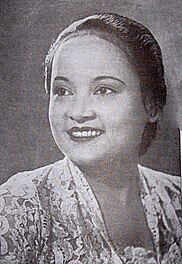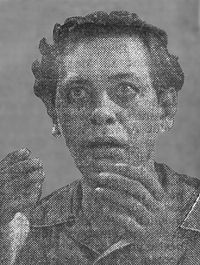Djaoeh Dimata
| Djaoeh Dimata | |
|---|---|
 Newspaper advertisement, Surabaya | |
| Directed by | Andjar Asmara |
| Written by | Andjar Asmara |
| Starring | |
| Cinematography | A.A. Denninghoff-Stelling |
Production company | South Pacific Film Corporation |
Release date |
|
| Countries | |
| Language | Indonesian |
Djaoeh Dimata
The first domestically produced feature film to be released in five years, Djaoeh Dimata received favourable reviews, although financially it was outperformed by Roestam Sutan Palindih's Air Mata Mengalir di Tjitarum (released soon after). The film's cast remained active in the Indonesian film industry, some for another 30 years, and SPFC produced six more works before closing in 1949. A copy of the film is stored at Sinematek Indonesia.
Plot

A poor villager, Asrad (Ali Joego), is blinded following a traffic accident and thus unable to work. As a result, his wife Soelastri (Ratna Asmara) travels to the capital, Jakarta, to find a job. As Asrad does not trust his wife and fears she may be unfaithful, he writes her a letter telling her not to return. Soelastri becomes a singer, and – unknown to Asrad – soon achieves wide acclaim. Her most popular song, "Djaoeh Dimata", receives heavy airplay on the radio and soon becomes one of Asrad's favourites. Ultimately Soelastri is brought home by Soekarto (Iskandar Sucarno), who attempts to pass her off as a maid for Asrad. When Asrad recognises his wife's voice, they are reconciled.[1]
Background
The first two years of the 1940s saw a growth in the cinema of the
After the
Production
SPFC hired
The film starred Ratna Asmara (wife of Andjar), Ali Yugo, Iskandar Sucarno, and Djauhari Effendi,[c][9] all of whom had previous theatrical experience. Ratna and Ali, together with Andjar, had been members of the travelling troupe Dardanella in the early 1930s and entered the film industry together in 1940 with Kartinah.[10] Iskandar and Djauhari, meanwhile, had been active in the theatre during the occupation; both made their feature film debuts with Djaoeh Dimata.[11]
A documentary detailing one day of the production, called Er wordt een film gemaakt ("A film is being made") exists in the Netherlands.[18][19]
Release and reception
Djaoeh Dimata was released in late 1948, the first domestic feature film since Berdjoang.[20] Despite this five-year gap, film critic Usmar Ismail writes that it did not stray from the formula which had been proven before the war,[21] one which Indonesian film historian Misbach Yusa Biran notes focused on songs, beautiful scenery and romance.[22] Roestam Sutan Palindih's Air Mata Mengalir di Tjitarum (Tears Flow in Citarum), which had similar themes, was released shortly after Djaoeh Dimata by the rival Tan & Wong Bros.; it proved the greater financial success.[23] Only three domestic productions were released in 1948; the last was another SPFC production, entitled Anggrek Bulan (Moon Orchid), which was also directed by Andjar.[24]
Reviews of the film, which was rated for all ages,[17] were mixed. One in the Jakarta-based Het Dagblad found the film to have many (unspecified) weak moments as well as strong ones. It particularly praised Ali's acting as a blind man, as well as Denninghoff-Stelling's camerawork.[25] Another reviewer, in the magazine Mestika, described Ratna as an "unprecedented tragedienne"[e] capable of making viewers cry "unrestrained tears of emotion".[f][26] After Djaoeh Dimata was released in Singapore in June 1949, a reviewer for The Straits Times praised the film's "fine photography and almost perfect sound".[27]
Andjar directed two further films for South Pacific, Anggrek Bulan and
Notes
- ^ Various contemporary spellings also include Djaoeh di Mata, Djauh Dimata, and Djauh di Mata.
- ^ The film was released during the Indonesian National Revolution, in which time Indonesia had declared itself independent while the Dutch East Indies was still formally in existence.
- ^ Sources do not indicate Effendi's role.
- ^ At the time, 130,000 gulden was officially the equivalent to US$ 50,000, with an exchange rate at 2.6 gulden to the dollar. Owing to the war, however, the black market price of dollars was four to five times as much (Mooney 1948, Holland).
- ^ Original: "... een tragedienne zonder weerga"
- ^ Original: "... zijn tranen van ontroering, niet bedwingen kan."
- ^ The Dutch had recognised Indonesia's independence after several months of negotiations. In the aftermath, the Indonesian government acquired Regerings Film Bedrijf, SPFC's parent company. It was merged with Berita Film Indonesia to form Perusahaan Pilem Negara (State Film Company), later renamed Produksi Film Negara (JCG, Berita Film Indonesia).
References
- ^ Filmindonesia.or.id, Djaoeh Dimata; Het Dagblad 1949, 'Djaoeh di Mata'
- ^ Biran 2009, pp. 385–387.
- ^ Biran 2009, pp. 339–343.
- ^ Danujaya & Tjasmadi 1992, p. 50.
- ^ a b Biran 2009, p. 359.
- ^ a b Encyclopedia of Jakarta, Andjar Asmara.
- ^ Sumardjo 1992, p. 247.
- ^ Filmindonesia.or.id, Max Tera.
- ^ Filmindonesia.or.id, Kredit Djaoeh Dimata.
- ^ Filmindonesia.or.id, Ali Yugo; Encyclopedia of Jakarta, Andjar Asmara
- ^ Filmindonesia.or.id, Djauhari Effendi; Filmindonesia.or.id, Iskander Sucarno; Het Vrije Volk 1948, 'Djaoeh di Mata'
- ^ Limburgsch Dagblad 1948, In Batavia Wordt.
- ^ De Vrije Pers 1948, Indonesische films.
- ^ Het Vrije Volk 1948, 'Djaoeh di Mata'.
- ^ Het Dagblad 1948, Camera draait.
- ^ Limburgsch Dagblad 1948, In Batavia Wordt; De Vrije Pers 1948, Indonesische films
- ^ a b De Vrije Pers 1949, (untitled).
- ^ "Er Wordt Een Film Gemaakt (14 November 1948)" (in Dutch). Retrieved 4 January 2019.
- ^ "Beeld En Geluid" (in Dutch). Retrieved 4 January 2019.
- ^ Said, McGlynn & Heider 1991, p. 3.
- ^ Ismail 1983, pp. 54–56.
- ^ Biran 2009, p. 25.
- ^ Biran 2009, p. 367.
- ^ Biran 2009, p. 385.
- ^ Het Dagblad 1949, 'Djaoeh di Mata'.
- ^ Quoted in Het Nieuwsblad voor Sumatra 1949, Een 'Anak Medan'
- ^ The Straits Times 1949, Indies Film.
- ^ Swestin 2009, p. 104.
- ^ Filmindonesia.or.id, Ali Yugo; Filmindonesia.or.id, Djauhari Effendi; Filmindonesia.or.id, Iskander Sucarno
- ^ Filmindonesia.or.id, South Pacific.
- ^ Filmindonesia.or.id, Djaoeh Dimata.
Works cited
- "Ali Yugo". filmindonesia.or.id (in Indonesian). Jakarta: Konfidan Foundation. Archived from the original on 8 August 2014. Retrieved 1 December 2012.
- "Andjar Asmara". Encyclopedia of Jakarta (in Indonesian). Jakarta City Government. Archived from the original on 4 July 2012. Retrieved 7 August 2012.
- "Berita Film Indonesia". Encyclopedia of Jakarta (in Indonesian). Jakarta City Government. Archived from the original on 1 January 2013. Retrieved 2 December 2012.
- ISBN 978-979-3731-58-2.
- "Camera draait in studio's van Multifilm 'Djaoeh di Mata'" [The Camera Turns in Multifilm's Studios for 'Djaoeh di Mata']. Het Dagblad (in Dutch). Jakarta. 11 November 1948. p. 2.
- Danujaya, Budiarto; Tjasmadi, Mohammad Johan (1992). Layar Perak: 90 Tahun Bioskop di Indonesia [Silver Screen: 90 Years of Cinema in Indonesia] (in Indonesian). Jakarta: Gramedia. OCLC 28028443.
- "Djaoeh di Mata". Het Dagblad (in Dutch). Jakarta. 13 March 1949. p. 2.[permanent dead link]
- "'Djaoeh di Mata' – een Indonesiesche film" ['Djaoeh di Mata' – an Indonesian Film]. Het Vrije Volk (in Dutch). Rotterdam. 4 December 1948. p. 6.[permanent dead link]
- "Djaoeh Dimata". filmindonesia.or.id (in Indonesian). Jakarta: Konfiden Foundation. Archived from the original on 2 December 2013. Retrieved 23 August 2012.
- "Djauhari Effendi". filmindonesia.or.id (in Indonesian). Jakarta: Konfidan Foundation. Archived from the original on 4 March 2016. Retrieved 1 December 2012.
- "Een 'Anak Medan' als Filmster" [An 'Anak Medan' as an Actress]. Het Nieuwsblad voor Sumatra (in Dutch). Medan. 3 March 1949. p. 2.
- "In Batavia Wordt Gefilmd 'Djauh di mata' eerste Indonesische speelfilm" [Filmed in Batavia: 'Djauh di Mata', the First Indonesian Film]. Limburgsch Dagblad (in Dutch). Heerlen. 26 November 1948. p. 5.[permanent dead link]
- "Indies Film in S'pore". The Straits Times. Singapore. 8 June 1949. p. 7 – via National Library of Singapore.
- "Indonesische films" [Indonesian Films]. De Vrije Pers (in Dutch). Surabaya. 11 November 1948. p. 2.
- "Iskandar Sucarno". filmindonesia.or.id (in Indonesian). Jakarta: Konfidan Foundation. Archived from the original on 20 October 2016. Retrieved 1 July 2013.
- Ismail, Usmar (1983). "Sari Soal dalam Film Indonesia" [A Summary of Issues Faced by Indonesian Films]. Usmar Ismail Mengupas Film [Usmar Ismail Discusses Film] (in Indonesian). Jakarta: Sinar Harapan. pp. 53–66. OCLC 10435722.
- "Kredit Djaoeh Dimata" [Credits for Djaoeh Dimata]. filmindonesia.or.id (in Indonesian). Jakarta: Konfidan Foundation. Archived from the original on 7 March 2016. Retrieved 1 July 2013.
- "Max Tera". filmindonesia.or.id (in Indonesian). Jakarta: Konfidan Foundation. Archived from the original on 2 December 2013. Retrieved 13 January 2013.
- Mooney, George A. (14 November 1948). "Holland Attacked on Indies Policies". The New York Times. pp. F1, F2.(subscription required)
- Said, Salim; ISBN 978-1-879578-00-5.
- "South Pacific Film". filmindonesia.or.id (in Indonesian). Jakarta: Konfidan Foundation. Archived from the original on 7 March 2016. Retrieved 1 December 2012.
- Sumardjo, Jakob (1992). Perkembangan Teater Modern dan Sastra Drama Indonesia [Development of Modern Theatre and Literary Drama in Indonesia] (in Indonesian). Bandung: Citra Aditya Bakti. ISBN 978-979-414-615-6.
- Swestin, Grace (July 2009). "In the Boys' Club: A Historical Perspective on the Roles of Women in the Indonesian Cinema 1926 – May 1998". Scriptura. 3 (2). Surabaya: Petra Christian University: 103–111. Archived from the original on 16 April 2014.
- "(untitled)". De Vrije Pers (in Dutch). De Erven J.A. Wormser Mogelijk freelancers. 18 May 1949. p. 4.


